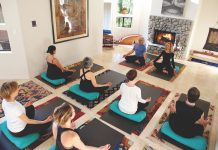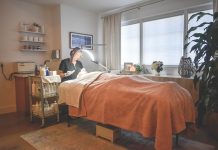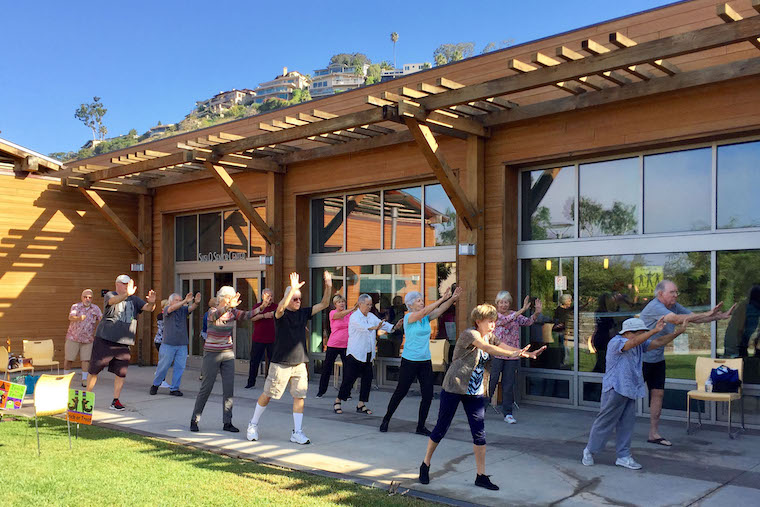
Exercise options abound for seniors and others with joint problems to stay fit without stressing knees, hips and ankles.
By Sharon Stello
With upbeat ’80s music pumping from a boombox, Leslie Davis leads her class in a series of stretches and strengthening moves. Since the class is taking place during a pandemic, Davis is in a room at the Laguna Beach Community & Susi Q Senior Center while the students are all at their homes, following the fitness session virtually on Zoom. However, Davis’ humor and lively spirit shine through the distance, motivating her students in this high-energy, but low-impact exercise session.
Make no mistake: While this class is easy on the joints, it’s no wimpy workout. “Man, you guys are making me sweat today,” Davis says during the class, which incorporates stretches as well as crunches, pushups and lifting 2-pounds hand weights.
The Stretch and Strengthen class—previously offered by the city of Laguna Beach, but now presented online by the Laguna Beach Seniors since last spring—is just one of many local classes and activities available for those seeking a low-impact fitness regimen. From swimming to cycling, walking, yoga and working with a personal trainer, there are plenty of options to stay in shape, which experts say is essential even as we age.
“It’s important for their vitality. The more you do, the longer you will be able to do it,” Davis says, noting the value of exercising and eating healthy. “… The real key always comes back to exercise.”
Brian Wisely, owner of The Well fitness studio, agrees that everyone should work out regularly. “Our well-being is enhanced when we exercise,” he says. “The benefits are physical, cognitive and emotional—body, mind and spirit.” For seniors, he adds, strength training is critical because “as we age, we slowly lose lean muscle mass and then get weak, which results in injuries and loss of balance and falling.”
Fitness classes often include a social component as well (even on Zoom), which is key for seniors who may feel isolated if they live alone. “Regular exercise also produces endorphins, which is the ‘feel good’ hormone and, so, exercise can help seniors feel satisfied and happy,” Wisely says.
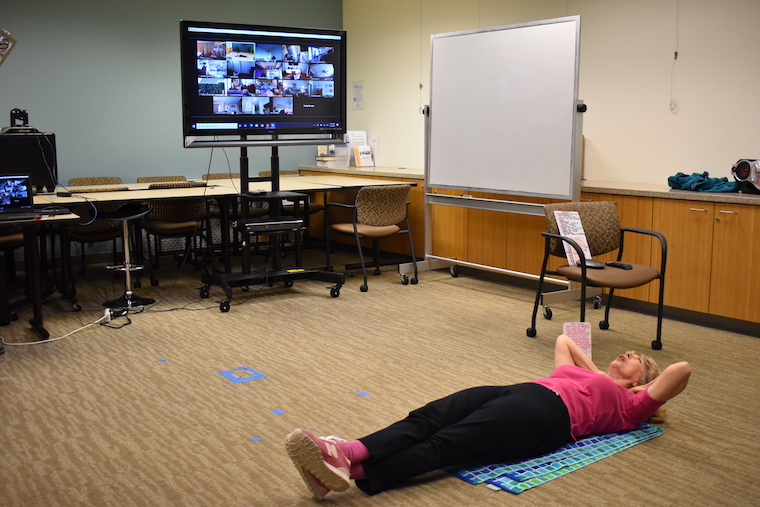
Stretch Sessions
Davis has been teaching the Stretch and Strengthen class for 21 years, after starting as a student and then taking over as instructor when Ian Harris moved away from Laguna. As Davis explains, Harris was a professional dancer until he injured his Achilles. To stay fit and help other injured dancers continue to exercise in a low-impact way, he created the Harris Method, which serves as the foundation for this class.
The moderately strenuous, aerobic workout includes both floor and standing exercises to improve stamina and balance while building lean muscle mass.
Most students in the class are in their 70s or 80s, Davis says. “This exercising has really kept my people alive and well and strong,” she adds. They do interval training twice during the hourlong class as well as weight training and really “push our lungs to the max.” Davis notes that over the years, a few people in their 40s accidentally signed up for this class intended for seniors, but they stayed and tried it. “One of them couldn’t even make it to the end [because of the intensity],” she says. Another said it was “challenging” and stuck around for about a year.
“We get everything exercised from our head down to our toes … the whole shebang,” says current student Dianne Card.
Peggy Donner, who has been taking the class for nearly 30 years, says in addition to working every muscle, she enjoys the upbeat music and Davis’ cheerful nature.
“Laughter—that’s our best medicine,” Davis says during class. She also keeps it fun by incorporating theme days like “wear your stripes Thursday” and starting each class with social time to catch up with everyone on Zoom. And the students aren’t only based in Laguna Beach but all over, including Scottsdale, Arizona, and a couple who are traveling around the country in an RV. “We’re really a little community of people,” Davis says.
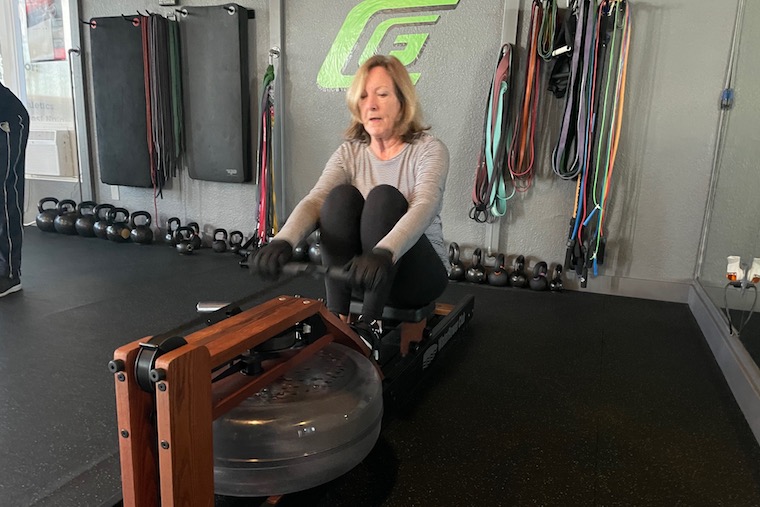
Flexible Fitness
Another low-impact fitness option is yoga and, while there are several classes offered in town—including some outdoors and on Zoom—one takes the joint-friendly approach a step further by only including standing poses plus a few done while sitting in a chair.
Wayne Lawrence has taught the Standing Yoga class at the Susi Q for about five years, taking over when the last instructor passed away. Lawrence was previously a student in the class and has worked with a mentor, local yoga teacher Carrie Pitt, to come up with ways to make the class doable for older seniors, like eliminating poses that require getting down on the ground and back up.
“So it’s changed a lot,” Lawrence says. “I’ve [also] brought back a lot of balance movements as well as muscle and joint builders.”
The students enjoyed the class so much, they requested that it be offered via Zoom after the pandemic set in. So, Lawrence, like Davis, teaches at the Susi Q and participants follow along from home. “It has been really popular,” he says. “… It has drawn a bigger crowd than the room we had it in could accommodate. … As far as Zoom goes, the sky’s the limit.” He notes that some even tune in while vacationing in Palm Springs.
“It’s wonderful to see seniors out there wanting to do something to improve their health and their movement and that’s what it’s all about,” Lawrence says. “It’s a low-impact and weight-bearing type of exercise.”
The class cycles through yoga poses to work on balance, flexibility and strength and also about 10 minutes of ba duan jin, a form of Chinese qi gong exercise that features slow, smooth movements.
“And with seniors, I always tell them, with your natural range of motion, if you can’t take your legs really wide for Warrior II, do what you can. And pretty soon you’ll be improving,” Lawrence says.
“… We work everything, standing or sitting, from the neck down to the ankles… [including] the knees—they need attention, they’re the first thing to go when we get older. Low-impact, but none-the-less, getting that synovial fluid going again in the knees. Every joint has synovial fluid: We just try to get them lubricated and working again.”
When sitting in a chair, they do moves such as spinal twists and quad lifts. “And, mind you, we’re not sitting back and relaxing in the chair,” Lawrence says. “You’re usually on the edge of the chair with a straight back and you work it.”
To sit down and get up from a chair, they use the Alexander Technique. “I’ve had students—I call them colleagues—… come up to me and say I can now get up out of a chair without grunting or having to ask for assistance. That is huge,” Lawrence shares. “One of the rewards that I get is when someone says to me that I feel so much better and my mood is so much better from taking your class.”
The oldest person in the class is 92 and Lawrence emphasizes the necessity for seniors to stay active. “If we don’t, the body just deteriorates and we’re going to be sitting and watching TV and unable to do anything else,” he says. “So, in my mind, one of the most important things we can do for our body is to keep moving. I know you’ve heard it before, move it or lose it.”
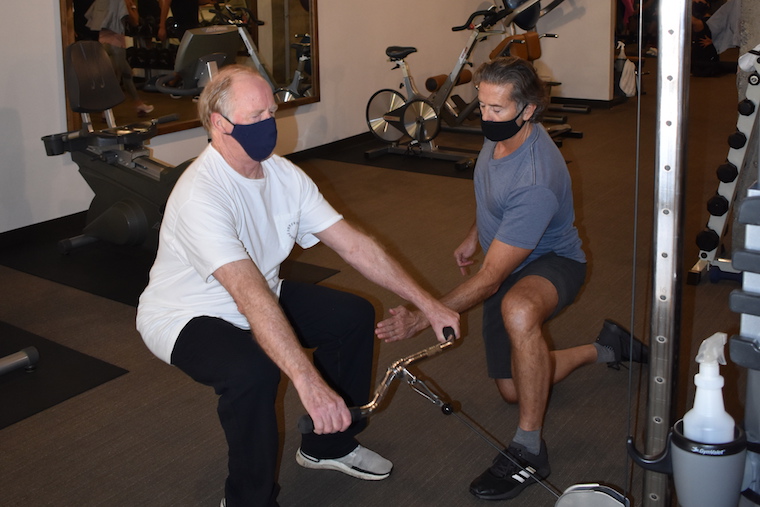
Getting Personal
Sometimes, those with joint problems are hesitant to start exercising again because they don’t know where to start and are scared about further injuring themselves. That’s where a knowledgeable personal trainer can be helpful by guiding a client through the process.
“Many people have joint issues and they are afraid that exercise will aggravate those problems,” says Ryan Kollock, a personal trainer who owns Code Green Fitness studio in Laguna. “The fact is, exercise can help by strengthening the muscles around the joints. The other issue may be inflammation, so changes in diet can also help with joint relief. Many people seek out a trainer because they are not sure where to start and are unclear of what they can and should do.”
Wisely, of The Well, notes that it’s a Catch-22 situation as “joint problems are an obstacle to regular exercise, and yet regular exercise done correctly can help improve joint problems.” “Many seniors seek a trainer so that they will exercise in a way that not only does not aggravate their joints but may even make their joints function better,” he says. “People also use a trainer for motivation and accountability. We often work with seniors who have completed some physical therapy for a joint issue. The physical therapist will provide us with detailed information about the nature of the client’s joint issue and together we will determine an exercise protocol to follow.”
Wisely has worked with several clients after they had full joint replacements. “One of my clients of many years—20-plus—has had both knees replaced. He is in his 70s and is now doing full squats and lunges pain free,” Wisely says. “Needless to say, his replacement surgeries were big successes. It’s my job to help keep his muscles, tendons and ligaments strong and functional for the future. We also have an 80-plus-year-old veteran who just had his second hip replacement. He is doing full range of motion squats now. He is a real success story for us.”
Kollock says there are several activities that people with joint issues can safely do. “Swimming, [riding the] recumbent bike, rowing, walking and hiking—these are great cardio exercises that get you moving and increase circulation,” Kollock says. “… Swimming is great because it takes all the pressure off your body.”
Generally, he recommends starting with 15 to 20 minutes and then working up to 45 minutes, three to four days a week, increasing time or distance every two to three weeks. “I would also add in strength training, which is even more important for maintaining muscle mass and bone density, three to five days a week,” he says. “This is where having a trainer makes a lot of sense, so you do not overtrain and get injured.”
As far as low-impact exercises that can be done at home, Kollock suggests planks, bridges, wall sits, standing on one leg, balancing and strength training: Try pulling and rowing movements with resistance bands. Other options are half squats and dead lifts, using bands for resistance if desired or while holding weights like dumbbells or kettlebells.
Wisely notes that the type of joint problem—tendonitis, severe arthritis or something worse—should dictate which exercises are selected. “For many conditions, exercise can help rehabilitate a joint, but in the case of severe arthritis, a joint replacement may be the only cure,” Wisely says. “Almost all exercises are a variation of the body’s primary movements, which are squat, gait, push, pull and core extension/flexion/rotation. These movements are the basis of functional strength training.”
“… In the case of tendonitis, we can usually strengthen muscles with … limited range of motion exercises that mitigate pain and increase blood flow to the joint, which results in healing,” Wisely says. “Performing movements with the proper mechanics and range of motion helps immensely.
“We use assisted exercises for those who cannot perform a movement without pain. Examples are the TRX bands, where a senior can use their upper body to assist in the movement. We also have a piece of equipment called Core Stix, which uses fiberglass poles to assist in movements of all sorts.”
Wisely offers training at The Well, at clients’ homes, on Zoom and outdoors, but, he notes, “it’s difficult to provide the options [at a client’s house or outside] that a well-equipped fitness studio offers.” The studio remains open at 20% capacity with extra sanitization in place, plus UV air purifiers have been installed for added safety.
Kollock only trains clients at his studio and in small groups outdoors, but he works with other trainers who will go to clients’ homes if requested. Kollock was also leading sessions via Zoom and he has recently been editing and posting workout videos on the Code Green Fitness YouTube channel (including some that can be done with just bodyweight and resistance bands) for clients who aren’t comfortable coming to the studio yet.
Among his offerings, Kollock leads small group workout classes with only two to four people to allow for social distancing, but these sessions hit all the bases: full-body core, strength and flexibility.
“I have worked with many seniors, athletes and people with injuries over the past 20 years,” Kollock says, adding that he focuses on core and proper form to avoid injuries. “… Low-impact cardio alone will not help with your bone density. You need to do resistance training.”
So whether you work with a personal trainer, go swimming, walking or take a low-impact class on Zoom, the experts agree, the key is to stay active in order to keep moving and feel great well into your golden years.
Laps and Loops
In addition to online classes and working with a personal trainer, swimming and hiking on easy trails are also low-impact options.
For those seeking the least impact on their joints, swimming reduces the effects of gravity to some degree, offering buoyancy as you do the freestyle, backstroke or simply tread water. The Laguna Beach High School and Community Pool, which is heated, remains open for lap swimming, but sessions must be reserved ahead of time. Only one 45-minute time slot may be booked per day up to three days per week. Available time slots are posted one week at a time, every Friday at 7 a.m. For safety during the pandemic, everyone coming to the pool must check in, have their temperature taken and wear a mask at all times when in the facility, except while swimming.
Or, head out on the trail for an easy stroll in nature. The following are easy, mostly flat paths, recommended by Paula Olson, outreach director for Laguna Canyon Foundation. In Laguna Coast Wilderness Park, take the Lake Trail from Dilley Preserve to Barbara’s Lake, a flat, out-and-back option that’s 1 mile each way. Or, start at the Nix Nature Center and take Mary’s Trail, a 1/4-mile interpretive loop with interactive stops, or Barbara’s Lake Trail, an out-and-back trail that’s 1/4 mile each way and goes under Highway 133 to Barbara’s Lake.
In Aliso and Wood Canyons Wilderness Park, try one of these three. From Top of the World, stroll down West Ridge Trail—“just a portion of it,” Olson says. “It is 2 miles in full length and the walk back up is deceivingly strenuous.” Over by Moulton Meadows Park at Balboa and Del Mar avenues, take the fire road to the 3/4-mile Aswut Trail. “Also, the fire road itself is an easy walk with beautiful canyon and ocean views,” Olson says. “We’ve used this when we’re hosting guests in wheelchairs.” And, at Awma Road Ranger Station, on Awma Road off Alicia Parkway (just south of Aliso Creek Road), “there is a lovely little interpretive path,” she says.


